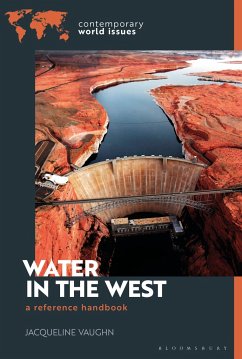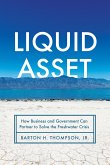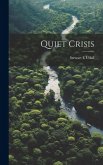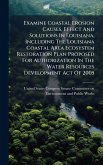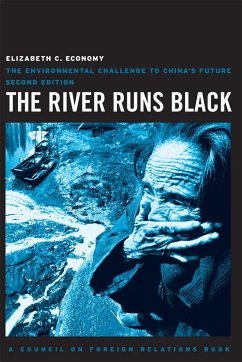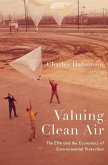- Gebundenes Buch
- Merkliste
- Auf die Merkliste
- Bewerten Bewerten
- Teilen
- Produkt teilen
- Produkterinnerung
- Produkterinnerung
Water use and conservation in the American West have long been shaped by a host of geographic, environmental, political and economic factors. Today, though, serious questions are being raised about how western states used dams, irrigation systems, and other water-related infrastructure to transform the landscape of the West. Are current trends in water consumption across the West sustainable, given the region's arid environment and rapidly growing populations? Are so-called "water wars" between thirsty states (and between Mexico and USA) worsening? What impact will climate change have on the…mehr
Andere Kunden interessierten sich auch für
![Climate Change and the EU Emissions Trading Scheme (ETS) Climate Change and the EU Emissions Trading Scheme (ETS)]() Larry ParkerClimate Change and the EU Emissions Trading Scheme (ETS)25,99 €
Larry ParkerClimate Change and the EU Emissions Trading Scheme (ETS)25,99 €![Liquid Asset Liquid Asset]() Barton H ThompsonLiquid Asset27,99 €
Barton H ThompsonLiquid Asset27,99 €![Quiet Crisis Quiet Crisis]() Stewart L UdallQuiet Crisis31,99 €
Stewart L UdallQuiet Crisis31,99 €![Examine Coastal Erosion Causes, Effect And Solutions In Louisiana, Including The Louisiana Coastal Area Ecosystem Restoration Plan Proposed For Authorization In The Water Resources Development Act Of 2005 Examine Coastal Erosion Causes, Effect And Solutions In Louisiana, Including The Louisiana Coastal Area Ecosystem Restoration Plan Proposed For Authorization In The Water Resources Development Act Of 2005]() Examine Coastal Erosion Causes, Effect And Solutions In Louisiana, Including The Louisiana Coastal Area Ecosystem Restoration Plan Proposed For Authorization In The Water Resources Development Act Of 200527,99 €
Examine Coastal Erosion Causes, Effect And Solutions In Louisiana, Including The Louisiana Coastal Area Ecosystem Restoration Plan Proposed For Authorization In The Water Resources Development Act Of 200527,99 €![Terrible Beauty Terrible Beauty]() Auden SchendlerTerrible Beauty22,99 €
Auden SchendlerTerrible Beauty22,99 €![The River Runs Black The River Runs Black]() Elizabeth C EconomyThe River Runs Black59,99 €
Elizabeth C EconomyThe River Runs Black59,99 €![Valuing Clean Air Valuing Clean Air]() Charles HalvorsonValuing Clean Air40,99 €
Charles HalvorsonValuing Clean Air40,99 €-
-
-
Water use and conservation in the American West have long been shaped by a host of geographic, environmental, political and economic factors. Today, though, serious questions are being raised about how western states used dams, irrigation systems, and other water-related infrastructure to transform the landscape of the West. Are current trends in water consumption across the West sustainable, given the region's arid environment and rapidly growing populations? Are so-called "water wars" between thirsty states (and between Mexico and USA) worsening? What impact will climate change have on the West's limited water resources--and the people who depend on them? This book answers all those questions and more, drawing on quantifiable facts and the knowledge and perspectives of experts on water resource consumption, administration, and conservation to provide a one-stop resource for understanding the past, present, and future of water in the American West.
Produktdetails
- Produktdetails
- Verlag: Bloomsbury Academic
- Seitenzahl: 280
- Erscheinungstermin: 6. Februar 2025
- Englisch
- Abmessung: 233mm x 162mm x 23mm
- Gewicht: 599g
- ISBN-13: 9798216182627
- Artikelnr.: 70965401
- Herstellerkennzeichnung
- Libri GmbH
- Europaallee 1
- 36244 Bad Hersfeld
- gpsr@libri.de
- Verlag: Bloomsbury Academic
- Seitenzahl: 280
- Erscheinungstermin: 6. Februar 2025
- Englisch
- Abmessung: 233mm x 162mm x 23mm
- Gewicht: 599g
- ISBN-13: 9798216182627
- Artikelnr.: 70965401
- Herstellerkennzeichnung
- Libri GmbH
- Europaallee 1
- 36244 Bad Hersfeld
- gpsr@libri.de
Jacqueline Vaughn, Ph.D., is professor emerita of political science at Northern Arizona University, Flagstaff, AZ, USA. Her published works include ABC-CLIO's Conflicts over Natural Resources: A Reference Handbook.
PREFACE
CHAPTER 1: WESTERN WATER CONFLICTS: BACKGROUND AND HISTORY
Introduction
Bringing Water to Los Angeles
Surface Water Sources and Challenges
Groundwater Sources and Challenges
The Evolution of Western Water Rights and Law
Native American Water Rights
Federalism and Interstate Water Agreements
Managing Water Across International Boundaries: Mexico and Canada
The Dam Builders of the West: The Bureau of Reclamation
The Other Dam Builders: The United States Army Corps of Engineers
Removing the Dams and Restoring the Rivers
The Other Water Agency: The United States Geological Survey
The Role of Non-Governmental and Non-Profit Organizations
Droughts, Megadroughts, and Water Scarcity
For Further Reading
CHAPTER 2: MOVING TOWARD WATER SUPPLY RESILIENCY: WESTERN WATER DEMANDS AND
COPING STRATEGIES
Introduction
Dividing Up the Colorado River
Contingencies and Conservation of the Colorado River
Arizona: Agriculture and Growth
California: Thinking Big, Really Big
Nevada: Conservation and the Southern Nevada Water Authority
New Mexico: Planning Beyond the Acequia
The Pacific Northwest: Challenges to Managing Water in Oregon, Idaho,
Montana, and Washington
The Rocky Mountain West: How Colorado, Utah and Wyoming Manage Water
Traditional vs. Alternative Water Management Strategies
Unconventional and Futuristic Strategies
For Further Reading
CHAPTER 3: PERSPECTIVES
Dr. Amrith Gunasekara, Director of Science and Research, California
Bountiful Foundation
Taylor Hawes, Colorado River Program Director, The Nature Conservancy
Dr. Jay Lund, Vice-Director, Center for Watershed Sciences, University of
California, Davis
Dr. Sally Manning, Environmental Director, Big Pine Paiute Tribe
CHAPTER 4: PROFILES
Alan Bible, Senator (NV)
Delph Carpenter, Advocate for a Colorado River Compact
Colorado Water Trust
Floyd E. Dominy, Commissioner, U.S. Bureau of Reclamation
John Samuel Eastwood, Dam Designer
Benjamin Harrison Eaton, Governor of Colorado
Carl Hayden, Senator (AZ)
Kyl Center for Water Policy
Elwood Mead, Commissioner, U.S. Bureau of Reclamation
William Mulholland, Superintendent, Los Angeles Department of Water and
Power
Patricia Mulroy, Superintendent, Southern Nevada Water Authority
Francis G. Newlands, Senator (NV)
John Wesley Powell, Colorado River Explorer
Marc Reisner, Environmental Writer
Philip David Swing, Member, House of Representatives (CA)
Water Education Foundation
Mark Wilmer, Water Rights Attorney
CHAPTER 5: DATA AND DOCUMENTS
List of Figures
Figure 5.1: Colorado River Allocation (Upper Basin by state)
Figure 5.2: Colorado River Allocation (Lower Basin, by state)
List of Tables
Table 5.1: Interstate Water Allocation Agreements of the West
List of Documents
Newlands Reclamation Act (1902)
Convention Between the United States and Mexico. Equitable Distribution of
the Waters of the Rio Grande (1907)
U.S. Supreme Court, Winters v. United States, (1908)
Colorado River Compact (1922)
Boulder Canyon Project Act (1928)
U.S. Supreme Court, Arizona v. Navajo Nation, (2023)
WaterSense Statistics and Facts
CHAPTER 6: RESOURCES
CHAPTER 7: CHRONOLOGY
GLOSSARY
ABOUT THE AUTHOR
CHAPTER 1: WESTERN WATER CONFLICTS: BACKGROUND AND HISTORY
Introduction
Bringing Water to Los Angeles
Surface Water Sources and Challenges
Groundwater Sources and Challenges
The Evolution of Western Water Rights and Law
Native American Water Rights
Federalism and Interstate Water Agreements
Managing Water Across International Boundaries: Mexico and Canada
The Dam Builders of the West: The Bureau of Reclamation
The Other Dam Builders: The United States Army Corps of Engineers
Removing the Dams and Restoring the Rivers
The Other Water Agency: The United States Geological Survey
The Role of Non-Governmental and Non-Profit Organizations
Droughts, Megadroughts, and Water Scarcity
For Further Reading
CHAPTER 2: MOVING TOWARD WATER SUPPLY RESILIENCY: WESTERN WATER DEMANDS AND
COPING STRATEGIES
Introduction
Dividing Up the Colorado River
Contingencies and Conservation of the Colorado River
Arizona: Agriculture and Growth
California: Thinking Big, Really Big
Nevada: Conservation and the Southern Nevada Water Authority
New Mexico: Planning Beyond the Acequia
The Pacific Northwest: Challenges to Managing Water in Oregon, Idaho,
Montana, and Washington
The Rocky Mountain West: How Colorado, Utah and Wyoming Manage Water
Traditional vs. Alternative Water Management Strategies
Unconventional and Futuristic Strategies
For Further Reading
CHAPTER 3: PERSPECTIVES
Dr. Amrith Gunasekara, Director of Science and Research, California
Bountiful Foundation
Taylor Hawes, Colorado River Program Director, The Nature Conservancy
Dr. Jay Lund, Vice-Director, Center for Watershed Sciences, University of
California, Davis
Dr. Sally Manning, Environmental Director, Big Pine Paiute Tribe
CHAPTER 4: PROFILES
Alan Bible, Senator (NV)
Delph Carpenter, Advocate for a Colorado River Compact
Colorado Water Trust
Floyd E. Dominy, Commissioner, U.S. Bureau of Reclamation
John Samuel Eastwood, Dam Designer
Benjamin Harrison Eaton, Governor of Colorado
Carl Hayden, Senator (AZ)
Kyl Center for Water Policy
Elwood Mead, Commissioner, U.S. Bureau of Reclamation
William Mulholland, Superintendent, Los Angeles Department of Water and
Power
Patricia Mulroy, Superintendent, Southern Nevada Water Authority
Francis G. Newlands, Senator (NV)
John Wesley Powell, Colorado River Explorer
Marc Reisner, Environmental Writer
Philip David Swing, Member, House of Representatives (CA)
Water Education Foundation
Mark Wilmer, Water Rights Attorney
CHAPTER 5: DATA AND DOCUMENTS
List of Figures
Figure 5.1: Colorado River Allocation (Upper Basin by state)
Figure 5.2: Colorado River Allocation (Lower Basin, by state)
List of Tables
Table 5.1: Interstate Water Allocation Agreements of the West
List of Documents
Newlands Reclamation Act (1902)
Convention Between the United States and Mexico. Equitable Distribution of
the Waters of the Rio Grande (1907)
U.S. Supreme Court, Winters v. United States, (1908)
Colorado River Compact (1922)
Boulder Canyon Project Act (1928)
U.S. Supreme Court, Arizona v. Navajo Nation, (2023)
WaterSense Statistics and Facts
CHAPTER 6: RESOURCES
CHAPTER 7: CHRONOLOGY
GLOSSARY
ABOUT THE AUTHOR
PREFACE
CHAPTER 1: WESTERN WATER CONFLICTS: BACKGROUND AND HISTORY
Introduction
Bringing Water to Los Angeles
Surface Water Sources and Challenges
Groundwater Sources and Challenges
The Evolution of Western Water Rights and Law
Native American Water Rights
Federalism and Interstate Water Agreements
Managing Water Across International Boundaries: Mexico and Canada
The Dam Builders of the West: The Bureau of Reclamation
The Other Dam Builders: The United States Army Corps of Engineers
Removing the Dams and Restoring the Rivers
The Other Water Agency: The United States Geological Survey
The Role of Non-Governmental and Non-Profit Organizations
Droughts, Megadroughts, and Water Scarcity
For Further Reading
CHAPTER 2: MOVING TOWARD WATER SUPPLY RESILIENCY: WESTERN WATER DEMANDS AND
COPING STRATEGIES
Introduction
Dividing Up the Colorado River
Contingencies and Conservation of the Colorado River
Arizona: Agriculture and Growth
California: Thinking Big, Really Big
Nevada: Conservation and the Southern Nevada Water Authority
New Mexico: Planning Beyond the Acequia
The Pacific Northwest: Challenges to Managing Water in Oregon, Idaho,
Montana, and Washington
The Rocky Mountain West: How Colorado, Utah and Wyoming Manage Water
Traditional vs. Alternative Water Management Strategies
Unconventional and Futuristic Strategies
For Further Reading
CHAPTER 3: PERSPECTIVES
Dr. Amrith Gunasekara, Director of Science and Research, California
Bountiful Foundation
Taylor Hawes, Colorado River Program Director, The Nature Conservancy
Dr. Jay Lund, Vice-Director, Center for Watershed Sciences, University of
California, Davis
Dr. Sally Manning, Environmental Director, Big Pine Paiute Tribe
CHAPTER 4: PROFILES
Alan Bible, Senator (NV)
Delph Carpenter, Advocate for a Colorado River Compact
Colorado Water Trust
Floyd E. Dominy, Commissioner, U.S. Bureau of Reclamation
John Samuel Eastwood, Dam Designer
Benjamin Harrison Eaton, Governor of Colorado
Carl Hayden, Senator (AZ)
Kyl Center for Water Policy
Elwood Mead, Commissioner, U.S. Bureau of Reclamation
William Mulholland, Superintendent, Los Angeles Department of Water and
Power
Patricia Mulroy, Superintendent, Southern Nevada Water Authority
Francis G. Newlands, Senator (NV)
John Wesley Powell, Colorado River Explorer
Marc Reisner, Environmental Writer
Philip David Swing, Member, House of Representatives (CA)
Water Education Foundation
Mark Wilmer, Water Rights Attorney
CHAPTER 5: DATA AND DOCUMENTS
List of Figures
Figure 5.1: Colorado River Allocation (Upper Basin by state)
Figure 5.2: Colorado River Allocation (Lower Basin, by state)
List of Tables
Table 5.1: Interstate Water Allocation Agreements of the West
List of Documents
Newlands Reclamation Act (1902)
Convention Between the United States and Mexico. Equitable Distribution of
the Waters of the Rio Grande (1907)
U.S. Supreme Court, Winters v. United States, (1908)
Colorado River Compact (1922)
Boulder Canyon Project Act (1928)
U.S. Supreme Court, Arizona v. Navajo Nation, (2023)
WaterSense Statistics and Facts
CHAPTER 6: RESOURCES
CHAPTER 7: CHRONOLOGY
GLOSSARY
ABOUT THE AUTHOR
CHAPTER 1: WESTERN WATER CONFLICTS: BACKGROUND AND HISTORY
Introduction
Bringing Water to Los Angeles
Surface Water Sources and Challenges
Groundwater Sources and Challenges
The Evolution of Western Water Rights and Law
Native American Water Rights
Federalism and Interstate Water Agreements
Managing Water Across International Boundaries: Mexico and Canada
The Dam Builders of the West: The Bureau of Reclamation
The Other Dam Builders: The United States Army Corps of Engineers
Removing the Dams and Restoring the Rivers
The Other Water Agency: The United States Geological Survey
The Role of Non-Governmental and Non-Profit Organizations
Droughts, Megadroughts, and Water Scarcity
For Further Reading
CHAPTER 2: MOVING TOWARD WATER SUPPLY RESILIENCY: WESTERN WATER DEMANDS AND
COPING STRATEGIES
Introduction
Dividing Up the Colorado River
Contingencies and Conservation of the Colorado River
Arizona: Agriculture and Growth
California: Thinking Big, Really Big
Nevada: Conservation and the Southern Nevada Water Authority
New Mexico: Planning Beyond the Acequia
The Pacific Northwest: Challenges to Managing Water in Oregon, Idaho,
Montana, and Washington
The Rocky Mountain West: How Colorado, Utah and Wyoming Manage Water
Traditional vs. Alternative Water Management Strategies
Unconventional and Futuristic Strategies
For Further Reading
CHAPTER 3: PERSPECTIVES
Dr. Amrith Gunasekara, Director of Science and Research, California
Bountiful Foundation
Taylor Hawes, Colorado River Program Director, The Nature Conservancy
Dr. Jay Lund, Vice-Director, Center for Watershed Sciences, University of
California, Davis
Dr. Sally Manning, Environmental Director, Big Pine Paiute Tribe
CHAPTER 4: PROFILES
Alan Bible, Senator (NV)
Delph Carpenter, Advocate for a Colorado River Compact
Colorado Water Trust
Floyd E. Dominy, Commissioner, U.S. Bureau of Reclamation
John Samuel Eastwood, Dam Designer
Benjamin Harrison Eaton, Governor of Colorado
Carl Hayden, Senator (AZ)
Kyl Center for Water Policy
Elwood Mead, Commissioner, U.S. Bureau of Reclamation
William Mulholland, Superintendent, Los Angeles Department of Water and
Power
Patricia Mulroy, Superintendent, Southern Nevada Water Authority
Francis G. Newlands, Senator (NV)
John Wesley Powell, Colorado River Explorer
Marc Reisner, Environmental Writer
Philip David Swing, Member, House of Representatives (CA)
Water Education Foundation
Mark Wilmer, Water Rights Attorney
CHAPTER 5: DATA AND DOCUMENTS
List of Figures
Figure 5.1: Colorado River Allocation (Upper Basin by state)
Figure 5.2: Colorado River Allocation (Lower Basin, by state)
List of Tables
Table 5.1: Interstate Water Allocation Agreements of the West
List of Documents
Newlands Reclamation Act (1902)
Convention Between the United States and Mexico. Equitable Distribution of
the Waters of the Rio Grande (1907)
U.S. Supreme Court, Winters v. United States, (1908)
Colorado River Compact (1922)
Boulder Canyon Project Act (1928)
U.S. Supreme Court, Arizona v. Navajo Nation, (2023)
WaterSense Statistics and Facts
CHAPTER 6: RESOURCES
CHAPTER 7: CHRONOLOGY
GLOSSARY
ABOUT THE AUTHOR

